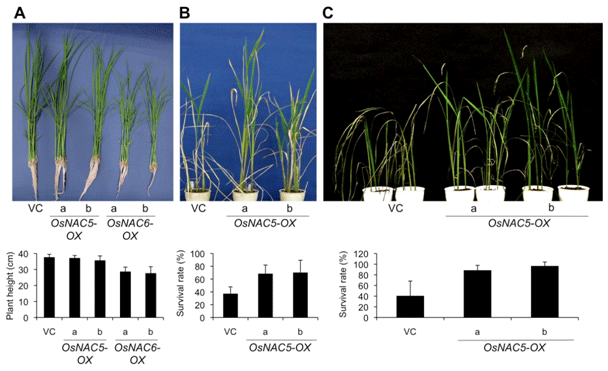Development of gene transfer technology to generate stress-tolerant rice plants utilizing the OsNAC5 gene
Description
In recent years, droughts and other extreme weather events occur frequently around the world and have a huge negative impact on crop yields. More particularly in developing regions, frequent droughts have caused severe damages to agriculture. When plants are exposed to adverse environmental conditions such as drought, though the function of genes involved in promoting tolerance to many environmental stresses, plants adapt to adverse environments. By causing overexpression of the transcription factor that regulates the function of these environmental stress tolerance genes, it is possible to improve environmental stress tolerance. However, in overexpressing the transcription factor genes involved in environmental stress tolerance, growth inhibition often occurs. This study is aimed to develop rice plants with improved tolerance to environmental stresses such as drought and salt stress without inhibiting the growth, using environmental stress-inducible NAC-type transcription factor genes in rice.
The transcription factor OsNAC5 in rice is a member of the plant-specific NAC family that regulates stress responses. Expression of OsNAC5, as well as OsNAC6, is induced by abiotic stresses such as drought, cold, high salinity, abscisic acid and methyl jasmonic acid. Transactivation assays using rice protoplasts demonstrated that OsNAC5 is a transcriptional activator, and subcellular localization studies using OsNAC5-GFP fusion proteins showed that it is localized to the nucleus. Pull-down assays revealed that OsNAC5 interacts with OsNAC5, OsNAC6 and SNAC1. To analyze the function of OsNAC5 in rice plants, we generated transgenic rice plants (Nipponbare) that overexpressed OsNAC5. The growth of T2 and T3 of the transgenic plants was similar to that of control plants, whereas the growth of OsNAC6-overexpressing transgenic plants was retarded (Fig. 1A). T2 and T3 of OsNAC5-overexpressing transgenic plants also had significantly improved tolerance to high salinity compared to control plants (Fig. 1B and 1C). Many stress-inducible genes, including the “late embryogenesis abundant” gene OsLEA3, were upregulated in rice plants that overexpressed OsNAC5. By gel mobility shift assay, OsNAC5 and OsNAC6 were shown to bind to the OsLEA3 promoter. Collectively, our results indicate that the stress-responsive proteins OsNAC5 and OsNAC6 are transcriptional activators that enhance stress tolerance by upregulating the expression of stress-inducible rice genes such as OsLEA3, although the effects of these proteins on growth are different. OsNAC5 may therefore be a useful gene that can improve the stress tolerance of rice without affecting growth.
Application of this technology is expected to decrease the damages caused by drought and salt in developing regions. In the future, it is necessary to verify the tolerance of the plants overexpressing OsNAC5 to hostile environments such as drought and high salinity at the field level.
Figure, table
-
Fig 1. Growth and stress tolerance of transgenic rice plants overexpressing OsNAC5.
(A) Height of transgenic rice plants overexpressing OsNAC5 (OsNAC5-OX) and OsNAC6 (OsNAC6-OX), and vector control plants (VC). (B) High-salinity stress tolerance of transgenic rice plants overexpressing OsNAC5. (C) Drought stress tolerance of transgenic rice plants overexpressing OsNAC5.
- Affiliation
-
Japan International Research Center for Agricultural Sciences Biological Resources Division
- Classification
-
Administration B
- Term of research
-
FY2006~2010
- Responsible researcher
-
TAKASAKI Hironori ( Biological Resources Division )
MARUYAMA Kyonoshin ( Biological Resources Division )
FUJITA Yasunari ( Biological Resources Division )
YAMAGUCHI-SHINOZAKI Kazuko ( Biological Resources Division )
NAKASHIMA Kazuo ( Biological Resources Division )
- ほか
- Publication, etc.
-
Takasaki et al. (2010) Mol Genet Genomics 284:173-183.
- Japanese PDF

